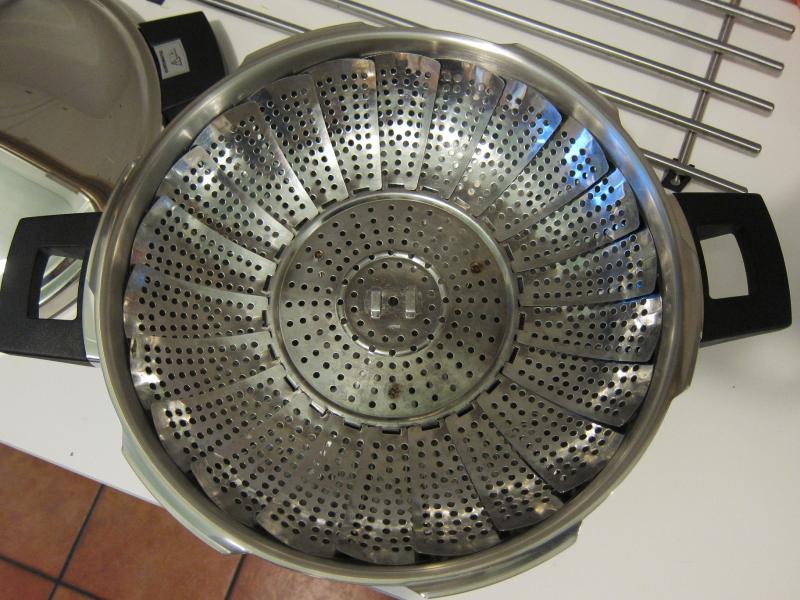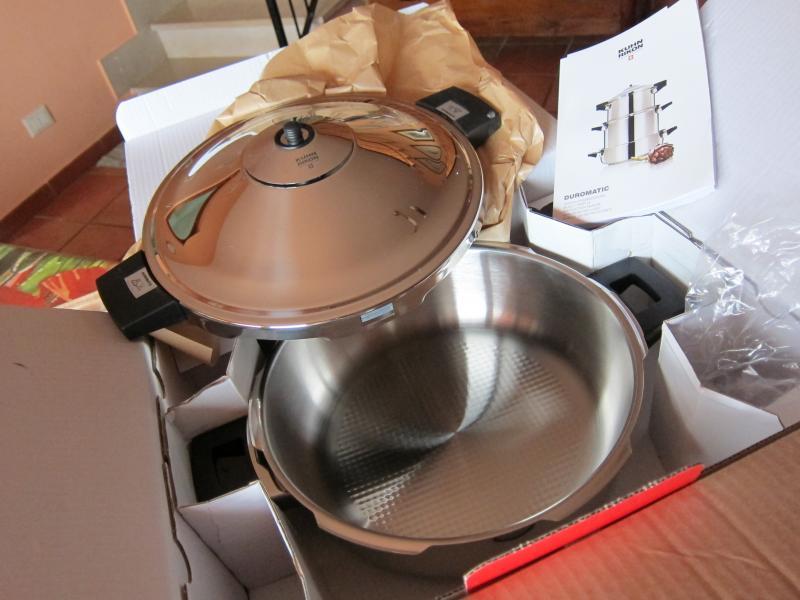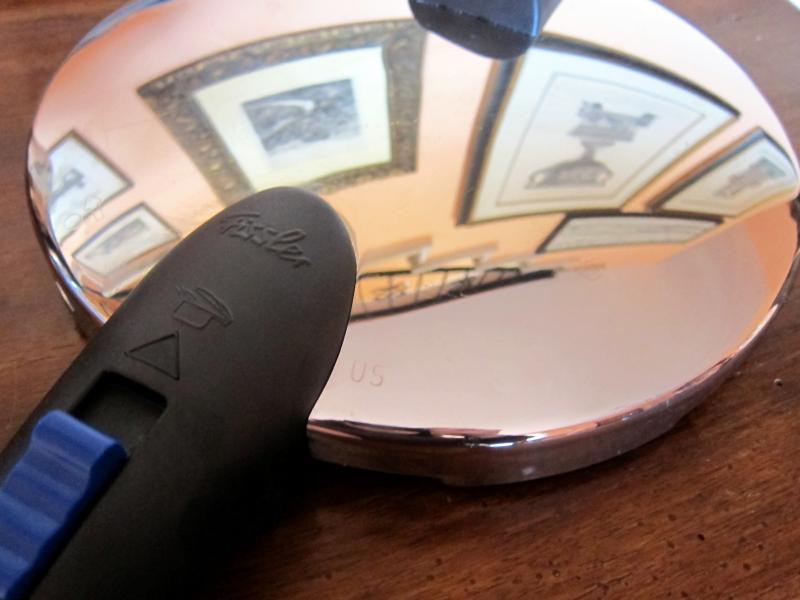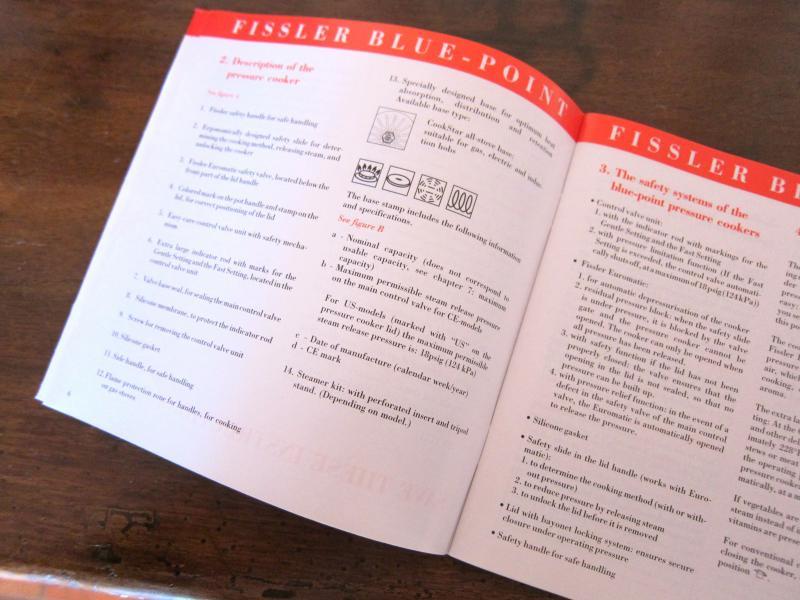-
Posts
182 -
Joined
-
Last visited
Content Type
Profiles
Forums
Store
Help Articles
Everything posted by pazzaglia
-
I don't have the 8L but the 5L braiser (low and wide), and 5L stockpot (tall and skinny) The braiser top and base weigh 4.04k while the stockpot weighs 2.87k. You're paying for the extra metal. I can assure you that there will be a similar difference between the two 8L models. In a pressure cooker, the lid takes most of the pressure - so having a larger surface area (616 cm2 for the braiser vs 380 cm2 for the stockpot) necessitates a heftier lid (the gasket is also significantly thicker). The wider base also requires a wider aluminum disk. The cost difference is commiserate with the materials used. All that being said, I do not recommend the braiser as your FIRST or ONLY pressure cooker. The shape is not conducive to doing advanced pressure cooking techniques that involve stacking multiple foods and cooking them at the same time. The Braiser is FANTASTIC for meat, but not only that. The larger area makes it easy to quickly sautee or brown veggies, and also evaporates and reduces liquids more quickly than the stockpot. I only recommend the braiser for people who already have one cooker and want to move all of their cooking to pressure cooking. Let me know if I can answer any more questions! Ciao, L
-
Haresfur, the problems you describe may be because your Fagor has not reached full pressure before you turned down the heat - this is a common frustration because their "pressure signal" actually signals the BEGINNING of pressure instead of full pressure. Fagor recommends waiting until it releases lots of steam (goes into over-pressure) before turning down the heat. I recommend an easier way: Just touch the pressure signal (the little dot that pops up). If it falls back down it has not reached pressure. If it's a little springy to the touch it is reaching pressure but not there yet. If it is hard and solid to the touch, it has reached full pressure and you can turn down the heat. The whole procedure could take anywhere from 3-5 minutes. This should make it easier to adjust the heat and expect it to stay there for an hour or more! Ciao, L
-
Yes, that's exactly it. Less- expensive pressure cookers usually have this problem. With a mid-range Fagor, for example, it can be tricky but you can eventually get the lid on. The thinner the stainless steel the more it can warp and expand when heated. German and Swiss pressure cookers that weigh a ton almost never warp but take forever to heat and reach pressure!!! The duromatic cook book says to use salt in quick-soaking, not regular soaking. Do they recommend brining beans for long-soak, too, now? I followed the ATK video to the letter (halving the quantities because I don't have a commercial 5L bin in which to soak my beans!). I used cannellini - which I often pressure cook soaked and not brined - then pressure cooked them for the recommended pressure cooking time - 7 minutes @ high pressure with natural release. Usually they are perfect, but they were falling apart - definately overcooked. So, I watched the video again, and noticed she said that brining the beans shortens their cooking time from soaked beans - so maybe they could have been done in just 5 minutes or .. who knows maybe less! There's alot of information compressed in that video. For example they say that the skin prevents the salt from going INTO the beans and brining creates different results than adding salt for quick-soaking or adding the salt during cooking. I highly recommend watching it several times to fully absorb what they're saying.. and then trying it! Ciao, L
-
Yes!!! Another thing to keep your pricey beans looking nice is to soak or quick-soak them in PLENTY of water - the added advantage of these soaks is the removal of those water-soluble indigestible sugars that.. uhm.. you know.. can be uncomfortable! Who has pressure cooked brined beans? I did and they turned into almost mush - so if brining catches on we will need new even SHORTER pressure cooking times for brined beans! Ciao, L
-
Linda, adding the lid when the contents are boiling also helps the cooker to reach pressure "faster". The advantages of this are not obvious with beans, but let's say you're making a tomato sauce that has a tendency to scorch. Being able to stir it until it begins to boil and generate steam will ensure the cooker will go up to pressure almost immediately once the lid is locked on. Conversely, putting all the cold tomato sauce ingredients in the cooker and turning it on could mean up to 10 minutes that the tomato sauce is in contact with the base without pressure (and at risk of burning). I put quotes around "faster" because there is no actual time difference between bringing things to a boil with a normal lid or a pressure cooker lid (the magic of pressure cooking only happens once the boiled is reached and vapor builds up pressure). Some of my readers also use this technique so they don't have to monitor the pressure cooker for 7-30 minutes (depending on how full it is) to watch it slowly build pressure. They just bring things to a boil (easier to see from across the kitchen) and then lock on the lid so the cooker begins to build pressure almost immediately and start cooking time length. Ciao, L
-
To elaborate on dcharch's instructions for the pressure cooker bain marie method for cooking rice... I wouldl ike to add 2.1 Most pressure steamed rice using the bain marie method needs only a 1:1 rice to water ratio. 2.5 Add one cup of water in the pressure cooker, then a trivet or steamer basket, and then the heat-proof container with the rice and water. because there is plenty. Pressure steam 3-5 minutes depending on the rice variety. Brown rice needs about 1 1/3 cup of liquid per grain and should be pressure steamed 15-20 minutes. Open with natrual release. Ciao, L
-
Your risotto photo looks beautiful! Cannoaroli has one of the highest starch contents so it's easy to get it creamy. For Arborio, try using the ratio of 1 cup grain to 2 cups stock. Rice just keeps absorbing and absorbing liquid until it busts open, and the it absorbs s'more. What might look "overcooked" is really just over-absorbed. Unfortunately, with pressure cooking you have to be very precise with ratios since there is no evaporation (only 3.5% vs. 30% in no-lid cooking). Adding vegetables (which are 80-95% water) can easily throw off these ratios. I actually add the vegetables to my measuring cup and use dis-placement of water to my advantage. Translation: For my small family of 4 I use two cups of rice, and use a 1L (4 cup) container to measure. I add a couple of chopped zucchini and top the rest off with stock with just a tad more. I have a detailed pressure cooker grain ratio and timing table, which can be a helpful launching point for your future experiments! Ciao, L
-
CONGRATULATIONS!!! Which one did you get, the elctric or stove-top? Ciao, L
-
Obviously, I jest about the pressure cooking time of garlic to bring the point home about the mustard seeds my original comment: if someone claims to achieve the same results by boiling mustard seeds for 45 min that MC produces by pressure cooking for 2 hours - one must wonder if other results could be achieved in a shorter time. Since my goal is to develop a time table about when certain spices soften I very interested in the methods used by MC but do not see them as definitive source of information. I would like to hear what everyone has tried or found incidentally as a starting point for my experiments - which will now start at the pressure cooking equivalent of a 45 minute simmer for mustard seeds. Back to the roasted garlic. If you read my technique, I am not trying to replicate MC garlic confit. Instead, my goal was to replicate what is happening in the oven using the foil packet - which indeed steams the garlic and then brings the olive oil to a boil to caramelize it. Maybe I was wrong to kid about re-engineering MC garlic but I don't think it was out of line to question how MC arrived at their pressure cooking times. Ciao, L
-
Linda I'm so glad you liked it! One of my readers solved the peeling problem by sending me this video: I still can't commit 2 hours to pressure cook a jar but a whole caramelized garlic clove sounds delicious. When testing the roasted garlic, I sprinkled a little raw (demarara) sugar to promote caramellization on one of the bulbs. It was DELICIOUS - a bit like garlic brulee' but only relevant to the most die-hard garlic lovers and haute home cooks! Ciao, L
-
I just found out (haven't tried) that you can boil mustard seeds at for 45-60 minutes with the same effect as pressure cooking for 90: http://www.thekitchn.com/a-condiment-with-class-mustard-caviar-166307 Since I just re-engineered Modernist Cuisine Roasted garlic from being pressure cooked in 2 hours to 5 minutes ... http://www.hippressurecooking.com/2012/02/stinking-rose-perfectly-roasted-garlic.html ...I do wonder about how the Modernist Cuisine arrive at their pressure cooking times and if they tested the results at shorter times! Ciao, L
-
Jump on the Duo if it's almost the same price as the Splendid - that is their economy model. I see from the links that you also get accessories with the Duo that are not included with the Splendid. Spend the $2 and get two pressure settings AND accessories! Ciao, L
-
Fascinating! So, would you say the result was soft mustard seeds after boiling 90 minutes at high pressure? Sesames just take a few minutes under pressure, not an hour and a half, to become soft- unless perhaps MC is referring to UN-shelled sesames (with which I do not have any actual experience). Have you tried sesame seeds, too? Ciao! L
-
I'm compiling the first-ever pressure cooking time table for seeds, nuts and spices. I will compile a preliminary time-table with your answers and then go through and test each one to write the definitive pressure cooking time. The goal is to list the cooking time until "soft". Hopefully these cooking times will spur more creativity in addition to the oft-mentioned "pine nut risotto" but also allow use for usually hard-as-rock spices to be used as garnish, or... who knows! My goal, anyway is to have all of this information in one place so at least there is a reference for this information that is free and online. I'm interested to know, if in a stock or curry or on purpose.. you ever included specific spice, nut or seed and found it soft. If so, for how long did you pressure cook it? Here is what I've got so far... DRAFT Pressure Cooking Time Table for Spices, Nuts & Seeds Let's hear which of these YOU pressure cooked and if there are any more to add to the list! Ciao, L
-
Hmm... maybe there is a "medium" - I've only ever seen these as large or small. Here's the big one. Ciao, L
-
Ciao Enrique, I have the non-factory everyday "flower petal" steamer baskets in two sizes - small and large. I just checked and the bigger one fits nicely in the Kuhn Rikon 5L Braiser/Pressure Pan - you do need to remove the center stem to get the lid on, though! But you can pull these out by either screwing the little center thing back in, or folding the "petals" with tongs, and then pulling it all out with oven mitts. I'm sure you'll find them at your local Euro shop! Here is a picture of my small one - so at least you can know what they look like. Maybe you already have one hiding in a deep dark corner of your kitchen?!? Ciao, L
-
Kuhn just sent me their 5L "Braiser" (pressure pan). I compared it to my 5L "stockpot" (pressure cooker) and here is the difference in weight. Kuhn Rikon 5L Pressure Cooker: 6.34lbs or 2.87kilos Kuhn Rikon 5L Pressure Pan: 8.97lbs or 4.07kios There is about a quater more materials in pressure pan vs. the pressure cooker. I imagine the 8L models will be significantly heavier - empty! I have just published the Kuhn Rikon Duromatic review and I was happy to discover during the fact-checking stage that this pressure cooker is COMPLETELY safe despite the lack of self-locking handle plus (this will be of interest to those who already have one) an undocumented, faster, way to open it! http://www.hippressurecooking.com/2012/02/pressure-cooker-review-kuhn-rikon.html Ciao! L
-
I'm not familiar with slow-cookers, but pressure cookers have a maximum 2/3 capacity for most foods and 1/2 capacity for foamy foods (grains, beans, some fruits). Your 8 quarts would have an actual capacity of about 5.25 quarts and 4 quarts respectively. It does not harm the pot. The only difference is that you need to meet the minimum water requirement for the size of that pot. I believe the 8qt needs just a tad more than one cup (maybe 1.25? it depends on the model) to reach pressure. This only degrades the food if you using a larger pressure cooker for a small amount of food, or you want to do a braise- where you want the minimum amount of water to BRAISE and not BOIL the food. Also, all of the extra metal to heat-up means the pressure cooker could take several minutes more to reach pressure and the small amount of food is cooking during that time so just be aware that you'll have to follow the pressure cooking time range on the low side. The only comment I can give on the price difference is that the base of the wider pan will need more metal on the base for the aluminum sandwich, and the top is subjected to more square inches of also needs to be stronger so this would affect the cost to manufacture it. How Kuhn Rukon then decides to price it is really up to them. I wrote a recipe specifically for the pressure pan and describe the benefits of having a pressure pan. I specifically address the difference between stacking vs. putting meat it in a single layer (after the turkey wing centerfold photo): http://www.hippressurecooking.com/2011/11/pressure-cooker-cranberry-braised.html In short, the benefits of a pressure pan vs. the same size pressure cooker are: larger area in direct contact with the heat source, faster time to pressure and faster evaporation (for when you need to reduce the liquid). All these are great for meats but if you make a soup, be sure to cover the pan so the contents don't reduce significantly by the time the family comes back for seconds! Ciao, L
-
That is correct, when the second red ring first appears you have reached .8 bar, but it continues to go up and you can lower heat and maintain pressure at any point until it goes up too high and reaches 1.2 bar and begins automatically releasing excess pressure. Think of the Kuhn Rikon pressure indicator rod as a measure of between 0-17.5 PSI with notches at 6 and 11.5PSI but it can maintain the pressure anywhere above and below those notches until it maxes out at 17.5. Though the notches may not be in the same same location, the same is true for the Fissler Blue Point and any other pressure cooker where you select the pressure via the distance of the rod coming out of the top. L
-
I have attached a photo of the manual page that states the pressure and where to look for the engraving on the lid to distinguish a US lid from a European world-wide lid. Does your Blue Point have the engraving "US" on the lid? I am in contact with several European manufacturers and since my website has a readership all English-speaking countries I take the differing standards seriously! Especially because I live in Europe and 80% of my readers are American. European pressure cooker manufacturers make a special model ONLY for the United States & Canada (to 15PSI) and Asian Market (with a third pressure setting). U.K., Australia & New Zealand, India and South Africa all other non-english speaking countries have the same models that are sold in Europe (around 13 PSI) - though some countries like Turkey and Saudia Arabia have customized exterior designs applied to the exterior. I, personally, have not found an "official" reason as to why in Europe the standard is 13 and America it's 15 it's very likely to be legacy and marketing issues. Imagine trying to find a recipe for a pressure cooker if every company made a pressure cooker that reached a different pressure! America (which has a different way to measure things from the rest of the world) had it's own separate pressure cooking manufacturing revolution in the 30's and 80's mainly fueled by American manufacturers who all wrote recipes for the 15PSI standard. In fact, UL Rating, which is an American Appliance Testing standard only says "15PSI or less" (http://ulstandardsinfonet.ul.com/scopes/0136.html) so an un-savvy European manufacturer could try to sell their 13PSI pressure cooker in the U.S. but it probably won't do very well. In Europe, rules for the CE rating only states that a "simple pressure vessel" can be above .5 bar (7.2 psi) and below 50 bar (720 PSI) before having to adhere to further restrictions (http://eur-lex.europa.eu/LexUriServ/LexUriServ.do?uri=OJ:L:2009:264:0012:0029:en:PDF). The 13PSI limit could have come about either by the specific standards of individual EU Member countries - if just one country has a limit and it's not a very big market (like U.S.) it doesn't make sense to make a pressure cooker just for them. If several countries have differing standards it makes sense to build one that could be sold in all. From the manufacturer's standpoint there has to be a threshold where it doesn't make sense to make a pressure cooker any more powerful in terms or pressure(most veggies are ready in 5 minutes or less at 13psi), cost of materials, and safety. I am not trying to defend a specific manufacturer.. but the critical mis-information being doled out by a "respected" and published pressure cooking author who applies restricted knowledge of U.S. packaged foods and pressure cookers world-wide with the simple irresponsible stroke of the keyboard. And, as evidenced by your googling, it worked very well and was being passed again, as fact. If you have any more lingering doubt, after reading my above essay with sources, links and photos.. I strongly encourage you to contact the manufacturer and ask them directly at what pressure their pressure cookers operate. Don't believe everything you find on google, or even Wikipedia for that matter - I've given up trying to update the pressure cooker page since my entries and reference links are always deleted. I take mis-information very seriously so any appearance of snarkyness in my post is not directed at you but the sources of such. L
-
SEB also makes the same pressure cooker in Italy, under the name Lagostina Acticook: http://www.lagostina.it/collections/PENTOLE-A-PRESSIONE/Acticook/Acticook45.htm From my understanding it has a spring-valve which would qualify it as a non-venting pressure cooker. However, I have not seen a model from them designed for the U.S., yet. If you were to purchase one from France, remember that you will need to purchase replacement parts (gaskets, etc.) from France as well. Ciao, L
-
I, personally, have a Blue Point and the manual states the ACTUAL maximum pressure - and it's 15PSI. If the metal lid, next to the handle has a little "U.S." engraved in it then you can be sure of it. If that "article on the web somewhere" was on a website of a certain pressure cooking "Miss" I can assure you that we ironed that out in her forums - she was referring to the online manual of the European model and not aware that the company specifically made a version for the U.S. This also explains why the Fissler Vitavit, which is currently in production and for sale in Europe is not yet available in the U.S. - they need to make and test tops just for this standard. Last year, I toured the German Fissler factories in person and they showed me differing machinery for making European and U.S. Pressure Cooker Tops - and the machine that tests them according to the pressure they are meant to withstand. What IS true, is that 14.5 PSI (1Bar or 100kPa) is often rounded up and referred to as 15PSI. Please don't spread vague knowledge without looking up the facts and information for yourself. Ciao, L
-
I'm game to pressure cook just about anything but ... I can do a roux in about 5 minutes the old way. I don't understand what problem is being solved by pressure cooking flour and fat in a jar for 90 minutes. Ciao, L P.S. Someone just invented wireless bicycle breaks. Only problem is... when the battery runs out they do not respond. Some things really don't need to be "improved" by technology!!
-

High Altitude Pressure Cooking and Stock Preparation
pazzaglia replied to a topic in Kitchen Consumer
The generally accepted rule for high-altitude pressure cooking is to increase the cooking time, and not the pressure. In theory, it should give you the same results - because, after all, pressure shortens the cooking time by raising the cooking temperature so a lower temperature would require a longer cooking time. I have not ACTUALLY tried this because I live at sea level on the shores of the Mediterranean Sea, but a few of my readers live in Colorado and have been able to pressure cook all kinds of recipes just by lengthening the cooking time. Here are the instructions by Fagor... "If you are cooking at high altitudes the cooking times must be longer, as water and cooking liquids come to a boil more slowly. A rule of thumb to remember is to increase the cooking time by 5% for every 1,000 feet above the first 2,000 feet ( 3,000 feet above sea level, add 5% to cooking time; 4,000 feet, add 10% ; and so on). Since the cooking times increase at altitudes higher than 2,000 feet, you will also have to add more cooking liquid to compensate. There are no fixed rules, so try increasing the cooking liquid by approximately half the percentage of the additional cooking time. For example, if the cooking time is increased by 10%, increase the cooking liquid by 5%." http://www.fagoramerica.com/about_us/article_library/about_pressure_cooking#Pressure Ciao! L -
Each size and brand of pressure cooker has it's own minimum liquid requirement - be sure to check your manual to see how little you can get away with. I haven't tried the caramelized carrot soup, but usually for shorter cooking veggie recipes you can also calculate how much moisture the veggies themselves will release during cooking - remember they are 85-95% water! I was able to char eggplants just enough to get a good Baba Ganoush going without needing to add ANY water to reach pressure. Just weigh the veggies and figure that one lb of veggies is a little less than 16 oz. of liquid. 8 (fluid) oz are equivalent to a cup. If you use less water than required to reach pressure, you not only risk not reaching pressure but also damaging the silicone and rubber gaskets and safety valves - they are easy, but a hassle, to replace. Ciao, L





